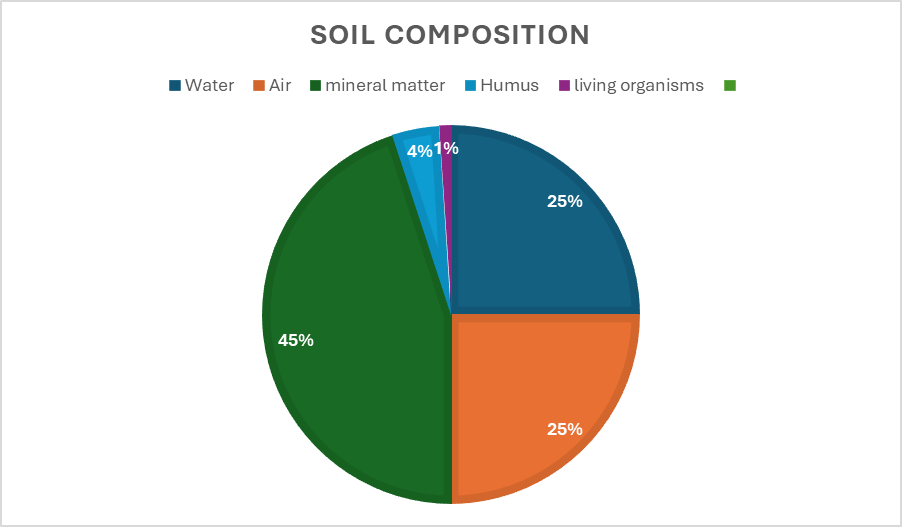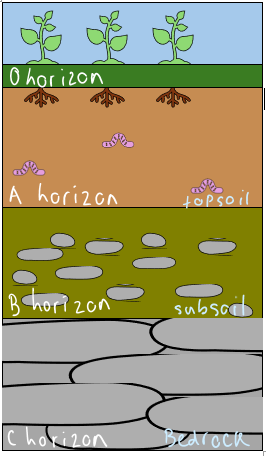Geography - Chapter 14 Soils

The composition of soil
Mineral matter
Humus
Air
living organisms
mineral matter
45% of soil
Largest component of soil
Comes from broken down bedrock
stones, sand, clay and silt
Helps nourish plants
Humus
4% of soil
Dark, jelly like substance
Rich in nutrients
forms when dead plants and leaves decay on top of the soil
process called ‘humification’
Living organisms mix material through soil
Helps bind soil together
increases fertility
Air
25% of soil
Found in space between soil particles
supplies oxygen and nitrogen
enables living organisms to live in soil
Water
25% of soil
Important, helps plants grow
dissolves nutrients and minerals
Living organisms
1% of soil
Earthworms and insects
burrow through soil, allowing water/air to pass
helps to mix the soil
bacteria and fungi also live here
help form humus
Soil profile
Cross section down through a soil
Shows the layers that make up the soil
These layers are called horizons

O horizon
The soil surface we see
Leaves, branches that decompose to form humus
A horizon
Topsoil
has highest humus content
this layer contains the most living organisms
B horizon
Subsoil
lighter in colour
contains less humus
partially made up of rocks
C horizon
Bedrock
Consists of rock particles and solid bedrock
Types of soil
Brown soil
Ireland’s most common type of soil
dark brown
areas once covered in deciduous trees
Midlands, south, east Ireland
humification
rich humus moderate rainfall supply soil with nutrients
Fertile, well-drained soil
good for arable or pastoral farming
Podzol
Grey
Coniferous forests
cold, wet, upland areas
Wexford, Cork and Galway (West of Ireland)
Excessive rainfall-leaching
Leaching= the washing of nutrients down through the soil horizons
Impermeable layer- leaching
Impermeable= Water can not pass through it
Hardpan
Infertile and slightly acidic
Peat soils
Black
Limited plant litter available (deciduous)
mountain locations in the midlands
high levels of rainfall lead to waterlogging
leaching occurs
infertile soil
Gley
Blue-grey
impermeable bedrock or high percentage of clay
Ulster, north midlands, Clare, Limerick
Waterlogging occurs
Infertile soil
Exploitation of soil
Natural resource
A material in nature that we can utilize to improve life quality
Soils
foundation and nutrients for plant growth
Filter and store water we drink
protecting soil helps stop climate change
Provides antibiotics
Overgrazing
When too many animals graze in a limited space and remove the plant cover from soil.
exposes soil to wind and rain, which can remove topsoil
cause erosion
How soil is formed
Bedrock
Broken down by weathering
some rocks weather slowly (Impermeable) Granite
Others quickly (permeable) limestone
The type of rock effects the characteristics of the soil
Relief
highland areas are more wet, so there is more water in the soil
can lead to leaching or soil becoming waterlogged
less humus
Climate
Rainfall and temperature determine the rate at which the rock is broken down by weathering and erosion
freeze thaw action slowly breaks down rocks in colder areas
results in thin soil
wet areas leaching occurs
soils are then infertile
in dry areas soils are so dry water can’t get in